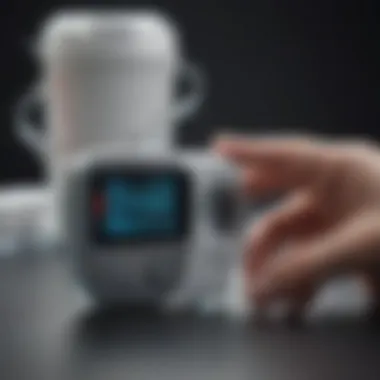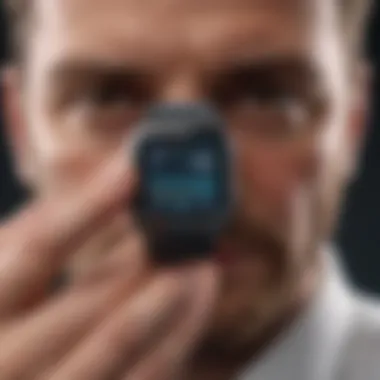Revolutionizing Glucose Monitoring Technology: A Comprehensive Exploration


Product Overview
Glucose monitoring technology has undergone a profound evolution, with traditional methods giving way to cutting-edge innovations. The narrative intricately traverses through the complexities of monitoring blood glucose levels, shedding light on the transformative potential of continuous glucose monitoring systems, wearable devices, and artificial intelligence integration in managing diabetes and enhancing overall health outcomes.
Performance and User Experience
The performance benchmarks of glucose monitoring technologies are paramount in showcasing their efficacy. User interfaces and software capabilities play a pivotal role in ensuring seamless integration into users' lives. Real-world user experiences and feedback serve as a litmus test, providing invaluable insights into the practicality and usability of these technological advancements.
Comparison with Previous Models or Competitors
Analyzing the advancements and improvements from earlier models is indispensable in gauging the trajectory of glucose monitoring technology. A comprehensive competitive analysis with other similar products unravels the unique value propositions of each offering. Understanding the competitive landscape aids in discerning the strengths and weaknesses of different products, fostering a culture of innovation and continuous improvement.
Tips and Tricks
Guiding users on how to optimize the performance of glucose monitoring devices can significantly enhance their experience. Unveiling hidden features and functionalities expands the horizon of possibilities for users, maximizing the utility of these technologies. Troubleshooting common issues equips users with the necessary knowledge to overcome challenges seamlessly, ensuring a smooth and efficient user experience.
Latest Updates and News
Staying abreast of recent developments in software updates and new features is imperative in harnessing the full potential of glucose monitoring technologies. Industry news and rumors surrounding upcoming products provide a glimpse into the future trajectory of diabetes management tools. Events and announcements from key players in the field, such as Apple, shape the narrative of innovation and progress in glucose monitoring technology.
Preamble to Glucose Monitoring Technology
Glucose monitoring technology stands at the forefront of healthcare innovation, driving advancements in diabetes management and overall health outcomes. In this article, we delve deep into the evolution, impact, and future trends of glucose monitoring. From traditional methods to state-of-the-art innovations, we unravel the complexities surrounding blood glucose level monitoring, offering a comprehensive guide for readers.
Historical Perspectives
The Origins of Blood Glucose Monitoring
The inception of blood glucose monitoring marked a pivotal moment in medical history, revolutionizing the way we understand and manage diabetes. The origins can be traced back to the development of portable glucometers, providing individuals with the ability to monitor their glucose levels conveniently. This technology's key characteristic lies in its accuracy and real-time feedback, empowering patients to make informed decisions about their health. Despite its advantages, the origins of blood glucose monitoring present challenges in terms of user calibration and device reliability, which are crucial aspects discussed in this article.
Evolution of Monitoring Devices
The evolution of monitoring devices represents a significant leap forward in glucose monitoring technology, with continuous innovation shaping the landscape of diabetes care. From basic glucose meters to advanced continuous glucose monitoring systems, the evolution highlights the industry's commitment to improving user experience and data accuracy. A key characteristic of this evolution is the integration of smart sensors and wireless connectivity, streamlining data collection and analysis for better health management. However, despite its benefits, the reliance on technology and potential for malfunctions are notable considerations in this article.
Key Importance of Glucose Monitoring
Role in Diabetes Management
The role of glucose monitoring in diabetes management cannot be overstated, serving as a cornerstone in effective treatment strategies. By measuring blood glucose levels regularly, individuals can take proactive measures to control their condition and prevent complications. The key characteristic of this role is its direct impact on medication adjustments and lifestyle modifications, enabling personalized care for each patient. While essential for disease management, challenges such as adherence to monitoring schedules and device accuracy are pivotal factors explored within this article.


Impact on Health Outcomes
The impact of glucose monitoring extends beyond diabetes management, influencing overall health outcomes and wellness strategies. By maintaining optimal blood glucose levels, individuals can reduce the risk of long-term complications and enhance their quality of life. The key characteristic of this impact is its preventive nature, emphasizing the importance of early intervention and continuous monitoring. Despite its advantages in promoting well-being, the financial burden of monitoring supplies and the emotional toll of constant vigilance are critical aspects discussed throughout this article.
Traditional Methods for Glucose Monitoring
Glucose monitoring forms the cornerstone of diabetes management, with traditional methods playing a vital role in this realm. These methods, albeit conventional, offer insights crucial for understanding the dynamic nature of glucose levels within the body. Fingerstick Blood Testing stands at the forefront of traditional monitoring techniques.
Fingerstick Blood Testing
Procedure Overview
Fingerstick blood tests involve pricking the fingertip to obtain a small blood sample, which is then analyzed using a glucose meter. This method provides real-time data on blood sugar levels, aiding individuals in making immediate dietary or medication adjustments. Its simplicity and quick results make it a popular choice among patients requiring frequent monitoring.
- Benefits
- Disadvantages
- Immediate results
- Minimal discomfort
- Invasive nature
- Potential for variability in readings
Limitations and Challenges
On the flip side, fingerstick blood testing presents limitations. The invasive nature of pricking the finger multiple times a day can lead to user fatigue and non-compliance. Additionally, factors like poor technique or environmental conditions can impact result accuracy, posing challenges in maintaining consistent monitoring practices.
- Noteworthy: While fingerstick blood testing remains a valuable tool, the field of glucose monitoring has witnessed significant advancements towards non-invasive and continuous monitoring solutions.
Oral Glucose Tolerance Test (OGTT)
Testing Process
The OGTT involves consuming a glucose solution followed by periodic blood tests to observe the body's response to sugar intake. This diagnostic test helps identify conditions like impaired glucose tolerance or diabetes. Despite being more time-consuming than fingerstick tests, OGTT provides a comprehensive assessment of glucose metabolism patterns.
- Advantages
- Disadvantages
- Detailed evaluation of glucose tolerance
- Detects subtle abnormalities in sugar processing
- Longer duration
- Discomfort due to glucose ingestion
Interpretation of Results
Interpreting OGTT results requires a nuanced understanding of blood glucose dynamics. Healthcare professionals analyze the patient's glucose curve to ascertain their tolerance levels. Abnormal patterns indicate potential risks, guiding personalized interventions for optimal management.


Important Note: OGTT contributes significantly to diagnosing conditions beyond traditional monitoring capabilities, offering a comprehensive view of glucose metabolism.
Important Note:
Advancements in Glucose Monitoring Technology
Glucose monitoring technology has witnessed significant advancements, shaping the landscape of diabetes management and overall health outcomes. In this article, we delve deep into the realm of these advancements, uncovering the core elements that propel this transformation. From continuous glucose monitoring (CGM) systems to wearable devices and the integration of artificial intelligence, the potential for revolutionizing glucose monitoring is immense.
Continuous Glucose Monitoring (CGM) Systems
Working Mechanism
Continuous Glucose Monitoring (CGM) systems operate by constantly measuring glucose levels within the interstitial fluid. This unobtrusive method provides real-time data to users, offering a comprehensive view of their glucose fluctuations. The key characteristic of CGM lies in its ability to alert users to hypo or hyperglycemic events promptly, enabling timely interventions for better glucose control.
CGM systems utilize subcutaneous sensors to monitor glucose levels continuously, eliminating the need for frequent finger pricks and offering a more streamlined approach to managing diabetes.
Despite its advantages, challenges such as sensor accuracy and calibration issues need continual refinement to optimize user experience.
Benefits and Challenges
The benefits of CGM systems are manifold, ranging from improved glycemic control to enhanced quality of life for individuals managing diabetes. Real-time feedback on glucose trends empowers users to make informed decisions regarding diet, exercise, and medication management. However, challenges like sensor insertion discomfort and data interpretation complexities pose hurdles that manufacturers strive to overcome.
The continuous feedback loop provided by CGM systems is invaluable in preventing hypoglycemia and hyperglycemia episodes, ultimately leading to better health outcomes.
While the advantages of CGM systems are clear, addressing challenges regarding sensor accuracy and user-friendly interfaces remains paramount in advancing this technology.
Wearable Glucose Monitoring Devices
Smart Sensors and Connectivity
Wearable glucose monitoring devices integrate smart sensors that enhance the accuracy and reliability of glucose measurements. The seamless connectivity options enable users to access their glucose data conveniently through mobile apps or cloud-based platforms. The key characteristic of these devices lies in their ability to provide actionable insights in real-time, fostering proactive diabetes management.
The integration of smart sensors and wireless connectivity in wearable devices simplifies the monitoring process, offering users a comprehensive view of their glucose trends anytime, anywhere.
However, limitations related to sensor durability and connectivity issues warrant attention for continuous improvement and user satisfaction.
User Experience and Convenience
The user experience offered by wearable glucose monitoring devices emphasizes comfort, discretion, and ease of use. The ergonomic design and functionality of these devices prioritize user convenience, promoting adherence to glucose monitoring routines. The key characteristic is the seamless integration of technology into everyday life, making glucose tracking a seamless part of daily activities.
The convenience offered by wearable devices empowers users to stay proactively engaged in their health journey, fostering long-term adherence to glucose monitoring protocols.


Despite the user-centric design of these devices, challenges such as data privacy concerns and technical glitches require attention to enhance the overall user experience.
Artificial Intelligence in Glucose Monitoring
Machine Learning Applications
Artificial intelligence algorithms play a pivotal role in glucose monitoring by analyzing vast amounts of data to predict glucose patterns and provide personalized recommendations. The key characteristic of machine learning applications in this realm is their ability to adapt to individual user profiles, offering tailored insights for optimized diabetes management.
Machine learning applications empower healthcare providers and individuals with valuable information for making informed decisions related to diet, exercise, and medication adjustments, leading to improved health outcomes.
However, challenges concerning data security and algorithm transparency necessitate ongoing advancements in AI ethics and regulation.
Enhancing Predictive Capabilities
AI-driven glucose monitoring solutions enhance predictive capabilities by forecasting future glucose trends based on historical data and real-time inputs. This proactive approach aids in preemptive measures to prevent glucose fluctuations and maintain stable blood sugar levels. The unique feature of enhancing predictive capabilities lies in its ability to empower users with foresight into their glucose management journey, fostering proactive decision-making.
The predictive capabilities offered by AI algorithms revolutionize diabetes management by bridging the gap between data analytics and actionable insights, enabling users to stay ahead of potential glucose imbalances.
While the potential of AI in glucose monitoring is promising, addressing concerns related to algorithm bias and data protection is vital for fostering trust and widespread adoption.
Future Trends and Innovations
In the domain of glucose monitoring technology, the section focusing on Future Trends and Innovations stands as a beacon of progress. With diabetes management at its core, the evolution of personalized glucose monitoring solutions foresees a spectrum of enhancements that cater to individual needs with precision.
Personalized Glucose Monitoring Solutions
Tailored Healthcare Strategies
Delving into Tailored Healthcare Strategies within the scope of personalized glucose monitoring unveils a bespoke approach to wellness. These strategies meticulously address individual variations in health profiles, aiming to optimize outcomes while acknowledging the nuanced nature of each person's health journey. The key emphasis here lies in customization, where tailored plans align with specific needs, offering a tailored path towards effective glucose management.
Tailored Healthcare Strategies exemplify a proactive shift from generic methodologies to targeted interventions. By tailoring healthcare plans to unique requirements, individuals witness a level of precision that traditional approaches fail to deliver. Granted, the distinctive feature of these strategies hinges on their adaptability, ensuring that no two plans are alike, tailoring treatment approaches to suit the individual's exact health demands.
Precision Medicine Approaches
Precision Medicine Approaches encapsulate the cutting-edge of healthcare precision. Within the context of glucose monitoring, precision medicine embodies a paradigm shift towards personalized care based on genetic, environmental, and lifestyle factors. The crux of this approach lies in its granularity, analyzing intricate details to craft highly specific interventions tailored to each individual's biological blueprint.
Embracing Precision Medicine Approaches equals embracing the future of healthcare, grounding treatments in a deep understanding of an individual's biological makeup. The defining feature of this approach remains its pinpoint accuracy, allowing for treatments that finely align with genetic predispositions and lifestyle choices. Though the advantages are evident in precision targeting, challenges such as cost and access to data underscore potential disadvantages.
Integration with Health Ecosystem
Adhering to the interplay between glucose monitoring and the broader health ecosystem illuminates the manifold ways in which these technologies synergize with healthcare landscapes. Integration with the health ecosystem folds intricate components like interoperability and data sharing alongside remote monitoring capabilities, elevating glucose management to a comprehensive, interconnected realm.
Interoperability and Data Sharing
Library again, Provide keyword-rich - ample content to update.
encyclopedias provide primary source information_

